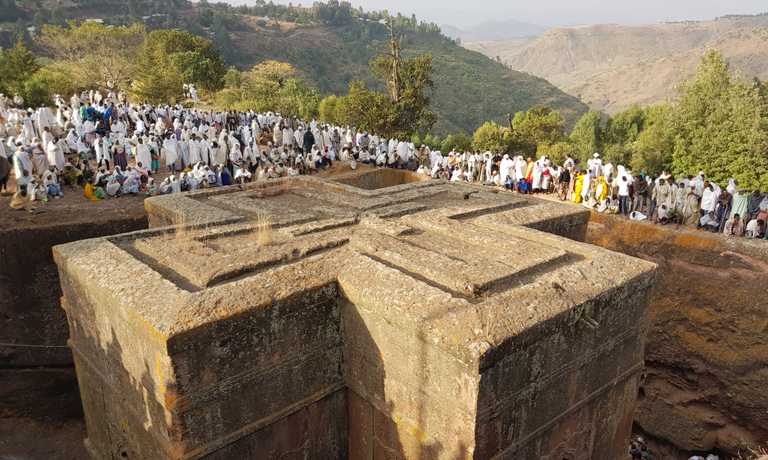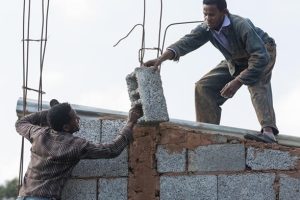
During a visit to Paris last October, Ethiopia’s Prime Minister Abiy Ahmed solicited support from French President Emanuel Macron for the restoration of the world-famous Lalibela RockHewn Churches in northern Ethiopia. After visiting the Lalibela Rock-hewn churches recently, President Macron on his part had pledged to give technical and financial support for the renovation of the churches.
A small portion of the 100 million euros France had granted to Ethiopia would go to the renovation of the Rock-Hewn churches. For long, we have been hearing the news that the magnificent Rock-Hewn Churches of Lalibela are under threat. The Rock-hewn Churches of Lalibela have suffered damage because of their age and in 2008 a metal roof was erected as a temporary solution to protect possible cracks and damages caused by sun slights.
That is why the site has been the object of several restoration campaigns; the main problem has been and still is the deterioration of the monolithic stone roofs of certain churches during the rainy season, as well as cracks in the exposed facades of several monuments. Back in November, an inaugural ceremony was held for the completion of a preservation project at the rockhewn church of Bete Golgotha Mickael in Lalibela.
The renovation work, which took eleven months, utilized innovative, non-intrusive, and proven techniques which were piloted during a previous project in 2016 at Lalibela. The U.S. Embassy through the U.S. Ambassadors Fund for Cultural Preservation funded the preservation work. A total of 500,000 USD (about 13.7 million Birr) was invested with an additional 119,500 USD in matching funds from the World Monuments Fund.
The U.S Embassy in the past has also supported the restoration of Bete Gabriel Rafael. Then after, another round of preparations has been underway to launch the restoration of Monolithic Rock-Hewn Churches. The refurbishment work, which would be undertaken in collaboration with various domestic and international institutions, keeping with its original values, is expected to be completed in three years.
Why the churches deserve so much attention? The Rock-Hewn Churches of Lalibela are the most extraordinary man-made heritage sites in Ethiopia. Lalibela, the main town in Lasta, is a mountainous region near a traditional village with circular-shaped dwellings located about 701km north of Addis Ababa in the North Wollo Administration Zone of Amhara state. Designated a UNESCO World Heritage site in 1978, the Lalibela churches are unique.
The courtyards surrounding these extraordinary places of worship are reachable only by staircases and tunnels. For instance, Bete Giorgies is carved from rock and sit below ground level, surrounded by deep, dry moats, with only their roofs visible. All the eleven churches represent a unique artistic achievement, in their execution, size and the variety and boldness of their form, according to the UNESCO World Heritage Centre.
The buildings are attributed to King Lalibela, who set out to construct in the 12th century a ‘New Jerusalem’. That is why Lalibela has an uplifted status in Ethiopian Christianity and is a place of pilgrimage and devotion. While many spectacular churches have been constructed in Ethiopia, perhaps the country’s most famous churches are the ones carved out of stone. Lalibela is the best example of Ethiopia’s rock-hewn architectural tradition.
The site Lalibela was originally called Roha, but it eventually took the name of King Lalibela, who ruled around 1200 C.E. as part of the Zagwe dynasty. King Lalibela is traditionally attributed as the builder of all the churches at the site. There are several legends and stories that surround the construction of the Rock-Hewn Churches. The most popular one was that an angel came to Lalibela and instructed for these churches to be built.
The same legends also claim that it took 24 years to build these churches. However, archaeologists refute this claim saying that this was an impossible feat. Even with today’s technology, accomplishing these kinds of structure within that span of time would not be possible. The Rock-Hewn Churches were built out of solid rock from top to bottom. They were excavated externally and internally. Moreover, they use different styles to carve out the details of these churches, as to a travel website everything-everywhere.
There are two main groups of churches to the north of Lalibela’s river called River Jordan: Biete Medhani Alem (House of the Saviour of the World), Biete Mariam (House of Mary), Biete Maskal (House of the Cross), Biete Denagel (House of Virgins), Biete Golgotha Mikael (House of Golgotha Mikael); And to the south of the river, Biete Amanuel (House of Emmanuel), Biete Qeddus Mercoreus (House of St. Mercoreos), Biete Abba Libanos (House of Abbot Libanos), Biete Gabriel Raphael (House of Gabriel Raphael), and Biete Lehem (House of Holy Bread). The eleventh church, Biete Ghiorgis (House of St. George), is isolated from the others but connected by a system of trenches.
Bite Geyorgisis shaped like a cross, but from above, has three doors and twelve windows. Each of the windows is adorned by a cross and floral motif carved in relief above its opening. An additional nine false windows are carved into the exterior of the church at the same level as the doors, but they do not open into the church’s interior. The churches were not constructed in a traditional way but rather were hewn from the living rock of monolithic blocks.
These blocks were further chiseled out, forming doors, windows, columns, various floors, roofs etc. This gigantic work was further completed with an extensive system of drainage ditches, trenches and ceremonial passages, some with openings to hermit caves and catacombs. According to UNESCO World Heritage Centre, Beite Medhani Alem, with its five aisles, is believed to be the largest monolithic church in the world, while Biete Ghiorgis has a remarkable cruciform plan.
Most were probably used as churches from the outset, but Biete Mercoreos and Biete Gabriel Rafael may formerly have been royal residences. Several of the interiors are decorated with mural paintings. Near the churches, the village of Lalibela has two story roundhouses, constructed of local red stone, and known as the Lasta Tukuls.
These exceptional churches have been the focus of pilgrimage for Coptic Christians since the 12th century. Various histories tell that the King of Lalibela set out to build a symbol of the holy land when pilgrimages to it were rendered impossible by the historical situation. At that time, his plan was to build the second Jerusalem, as Jerusalem is far from Ethiopian to go to and receive a blessing from its holy land.
Many Christians were often in trouble when going to Jerusalem, and it was intended to reduce their shortcomings and hardships. In the Church of Biet Golgotha, are replicas of the tomb of Christ, and of Adam, and the crib of the nativity. The holy city of Lalibela became a substitute for the holy places of Jerusalem and Bethlehem, and as such has had considerable influence on Ethiopian Christianity.
The whole of Lalibela offers an exceptional testimony to the medieval and post-medieval civilization of Ethiopia, including, next to the eleven churches, the extensive remains of traditional, twostory circular village houses with interior staircases and thatched roofs. The area, Lalibela, is also known for in relation with destination and movement of the Ark of Covenant.
The churches contributed a lot in making the area known to the outside world and an important center of a tourist destination. A considerable number of tourists, researchers and pilgrims set foot to the area every year. Most of the Ethiopian tourists visit these churches in connection with religious celebrations, such as Christmas and Epiphany. The number of foreign tourists also rises during these ceremonies.
The Ethiopian Herald, March 28/2019
BY ESSEYE MENGISTE





